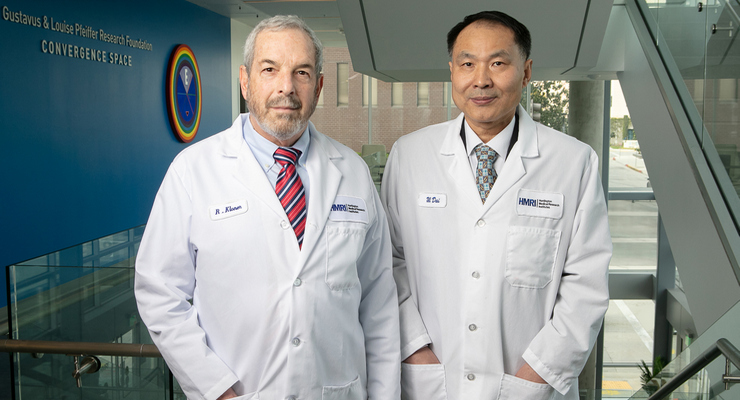
Robert A. Kloner, MD, PhD, chief science officer and chair of Cardiovascular Research at HMRI and professor of medicine (clinical scholar) at Keck School of Medicine of the University of Southern California, and Wangde Dai, MD, associate professor of Cardiovascular Research at HMRI, have markedly reduced stroke size using empagliflozin, a common antidiabetic drug.
In pilot studies, HMRI’s team of cardiovascular researchers, led by Robert A. Kloner, MD, PhD, chief science officer, chair of Cardiovascular Research, and professor of medicine (clinical scholar) at Keck School of Medicine of the University of Southern California, and Wangde Dai, MD, associate professor of Cardiovascular Research, showed a dramatic reduction in stroke size using empagliflozin, a common antidiabetic drug. Their research has major clinical implications.
Strokes are rising at alarming rates. Over a span of 29 years, from 1990 to 2019, the absolute number of incident strokes increased by 70%. HMRI’s investigators aim to improve lives through novel scientific discoveries that reduce the size and severity of heart attacks and strokes, addressing this increasingly urgent public health crisis.
When a person experiences a stroke, brain cells die either from blocked blood flow (ischemic stroke) or a ruptured blood vessel in the brain (hemorrhagic stroke). Every year in the United States, about 795,000 people experience a new or recurrent stroke; of those, 87% are ischemic, and 13% are hemorrhagic. A stroke-based study from 2017– 2020 estimates that 9.4 million Americans ages 20 and older have been diagnosed with a stroke. The global stroke epidemic is associated with increasing mortality, morbidity, and disabilities that can be detrimental to the survivor’s quality of life.
Dai presented the research group’s findings at the AHA Scientific Sessions. Scientists administered empagliflozin (EMPA), a sodium-glucose co-transporter-2 inhibitor, into a chronic treatment group for seven days before the experimental preclinical stroke model. They observed a significant reduction in the size of cerebral infarctions in stroke models. In the acute treatment group, EMPA was given intravenously ten minutes prior to the middle cerebral artery occlusion and one minute before reperfusion. The acute treatment reduced the size of the stroke by 74%. EMPA also reduced the swelling of the brain due to stroke.
EMPA started as an antidiabetic drug and now has cardiovascular indications as well. “We know that diabetes is a risk factor for stroke, but the exact mechanism as to why empagliflozin was so powerful in reducing stroke size remains to be determined,” said Kloner. “We hypothesize that it preserves the function of the mitochondria, the energy factories of the cells, and reduces reactive oxygen species or free radical damage.”
When patients enter the hospital with symptoms of a stroke, imaging procedures help physicians determine if a stroke is present — providing information on the type of stroke, size, and area of the brain affected. Some common therapies for ischemic strokes may include thrombolytic drugs to dissolve the clot, usually given within the first three hours of the onset of symptoms, or blood clot removal via thrombectomy. Hemorrhagic strokes may require potential surgery.
The financial burden of stroke on the healthcare system in the US is $34 to $40 billion annually. This includes direct costs, such as hospital stays, outpatient visits, and home health care, as well as indirect costs, such as lost wages and premature death.
“Even with modern approaches to treatment for stroke, death rates remain high and are increasing — and the subsequent disability costs are intolerable,” said Kloner. “There is an urgent need for new approaches that will better preserve brain cells in the setting of ischemic stroke and reduce the size of the stroke, also known as cerebral infarction.”
While their work currently remains experimental, HMRI’s researchers are hopeful. In the future, they speculate that EMPA could be administered preventatively for people with a high risk of stroke and acutely in the setting of stroke to reduce its size. However, more research is needed at the preclinical and clinical stages.
HMRI’s cardiovascular researchers will continue their studies on stroke to determine whether EMPA is effective after the onset of a stroke. They will also explore whether EMPA’s effect on reducing stroke size will improve neurological function long-term after a stroke.
Based in Pasadena, California, Huntington Medical Research Institutes (HMRI) is a pioneer in scientific research with a 70-year track record of groundbreaking discoveries that have changed the world — from seatbelts to lifesaving diagnostic technology like the MRI. Today, HRMI’s work is laser-focused on biomedical research investigating diseases of the heart and brain, and it is committed to inspiring and educating the next generation of scientists.


















